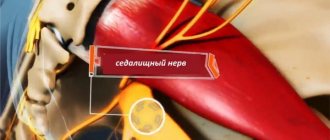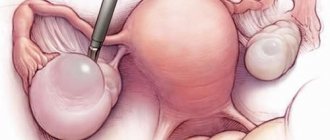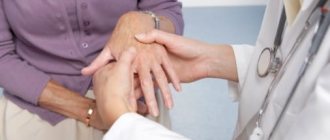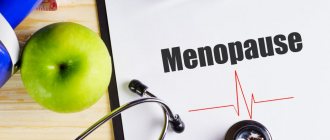Intercostal neuralgia is a pain syndrome: the sensation of pain occurs along one of the intercostal nerves. Acute, “shooting” pain in itself is a rather unpleasant factor, but in the case of intercostal neuralgia it is especially frightening. We usually interpret acute pain in the chest area as cardiac pain. If the nerve running between the lower ribs or the subcostal nerve (running under the lower rib) is affected, we may mistakenly believe that the source of pain is in the abdominal cavity.
What is intercostal neuralgia?
Neuralgia of the intercostal nerves is pain of a different nature that occurs due to various etiological factors. It is more often observed in adult men and women over 30-35 years of age. Symptoms of neuralgia may appear suddenly on one or both sides of the chest, along one or more intercostal nerves. The disease has an ICD code - M.79.2.
To understand what intercostal neuralgia is, you should understand the anatomical features of the thoracic nerves. There are 12 pairs in total. Each intercostal nerve contains motor, sensory and sympathetic fibers. It originates from the anterior roots of the spinal cord of the thoracic spine, passes along the lower edge of each rib, reaching the sternum. The parietal pleura covers the nerve fibers on top.
Thoracic nerves transmit impulses to the skin, the musculo-ligamentous apparatus of the chest and the anterior wall of the abdomen, partly the pleura and peritoneum, and the mammary glands. Sensitive fibers of neighboring nerve trunks actively interact with each other, creating cross innervation.
Treatment of thoracic neuralgia
Treatment of intercostal neuralgia is carried out in two parallel ways. The first method of therapy is partial or complete pain relief, and the second is treatment of the disease itself that caused the condition of neuralgia.
In most cases, the patient undergoes therapy at home. Moreover, depending on the severity of the disease, the patient is placed on bed rest from three days to a week. The bed must have a flat and hard surface. It is better if the bed is equipped with an orthopedic mattress, but if this is not possible, then you need to put something flat and hard under a regular mattress that can be adjusted at home. If the patient uses a bed during treatment, for example, with a sagging mesh, then his condition will only worsen.
Treatment with medications
For therapy prescribed:
- nonsteroidal anti-inflammatory drugs, for example, Diclofenac or Meloxicam. These drugs have an analgesic effect coupled with an anti-inflammatory effect. In addition, their zone of action affects the problematic nerve and can relieve syndromes of associated ailments. This type of medication is available in tablets, injections or suppositories;
- muscle relaxants - "Mydocalm" or "Sirdalud" - relieve discomfort in the form of spasms of skeletal muscle tissue;
- sedatives based on natural ingredients. These may be medications such as Sedosen, Persen, Novopassit and many others;
- vitamin B complexes, for example, Neurorubin. Their main effect is to restore damaged nerve roots and increase the interconnection between them.
To get rid of the symptoms of thoracic neuralgia, doctors prescribe medications
Spot treatment of neuralgia
The main method of local therapy is the application of dry heat to the affected area of the body. It should be noted that this method involves the use of an indirect source. Woolen items or down scarves are perfect for dry warmth. It is strictly forbidden to apply hot objects to the area affected by neuralgia - this can only cause harm to the patient. This process is due to the fact that with such heating, the blood flow of the problem area will first increase sharply, but then with cooling the pain may intensify, and the swelling will only increase.
In the local treatment of neuralgia, various ointments or gels based on non-steroidal anti-inflammatory components (“Deep-Relief” or “Fastum Gel”) are widely used.
Pharmacy medications in the form of ointments and gels without NSAIDs include anesthetics. Such drugs include Capsicam or Finalgon.
How to distinguish intercostal neuralgia from heart disease?
If neuralgia has acute symptoms in the thoracic region on the left side, differential diagnosis with heart disease must be carried out. You should not look for the cause of the pain syndrome on your own. Thoracalgia on the left side should always be a reason to consult a doctor.
Heart pain and symptoms of intercostal neuralgia on the left have distinctive features:
| Intercostal acute neuralgia on the left: typical symptoms | Cardiovascular diseases: characteristic manifestations |
| The pain intensifies with forced breathing, coughing, sneezing, laughing, physical exertion and movement, but does not change with fast walking and excitement. | The pain does not change its intensity with a deep breath or muscle tension, but intensifies with cardio exercise (fast walking, running, climbing stairs). |
| Chest neuralgia is not relieved by taking nitroglycerin | With angina pectoris, the pain attack goes away within 3-5 minutes after using nitroglycerin. With myocardial infarction, severe pain cannot be relieved with medications. In this case, you should immediately call an ambulance. |
| Normal pulse and blood pressure are determined | Changes in heart rate and blood pressure |
| Pain increases with palpation of the ribs and spaces between them | The intensity of pain does not change when palpating the intercostal spaces |
| Painful symptoms on the left “go” along the nerve or are encircling in nature | Pain is localized behind the sternum or in the projection of the heart |
Symptoms of intercostal neuralgia on the left and right should also be differentiated from other diseases (pleurisy, pneumonia, thoracic aortic aneurysm, pericarditis, acute pancreatitis and others). If there is severe pain in the chest, only a doctor can determine exactly what it is - neuralgia or another pathology.
Intercostal neuralgia in women & Intercostal neuralgia in men.
Intercostal neuralgia in men occurs as often as in women, but at the same time, intercostal neuralgia in women has its own characteristics. For example, women often perceive pain due to intercostal neuralgia as a manifestation of breast disease, and not as neuralgia. And it is clear that such thoughts can only cause additional anxiety and worry. But there is one consolation - although pathology of the mammary glands is indeed common, even if it is present, the vast majority of pain is not associated with it, but with the spine, nerves and muscles. This does not cancel periodic examinations with a mammologist, but it does mean that you should never panic. And most importantly, keep in mind that in medicine there is such a concept - a disease “in disguise”, when one disease is masked by another. Let's look at the insidiousness of this problem using our example. Pathology of the mammary glands is a psychological dominant that causes much more concern than intercostal neuralgia. Accordingly, if a woman simultaneously has thoracic intercostal neuralgia and pathology of the mammary glands, then all her thoughts will be focused on the glands. The rest will fade into the background. And it is quite natural that in this situation a woman, first of all, will turn to a mammologist. If the mammologist turns out to be knowledgeable, he will quickly figure out what is causing the pain: glands or neuralgia. And, if it is neuralgia, he will refer the patient to a chiropractor. By the way, it is the chiropractor who is the main doctor for intercostal neuralgia (but we’ll talk about this later). And if a mammologist comes across an inexperienced or over-insurer, what will he do? Most likely, having discovered his own profile pathology in the patient, he will also focus on this pathology and will not “dig” deeper. Consequently, if in reality the patient was bothered by pain due to intercostal neuralgia, and the pathology of the mammary glands was only a background that did not cause pain, then treatment by a mammologist will not solve the problem. The pain will remain. And this will cause the woman even more anxiety. Her faith in doctors will suffer. Your nerves and time will be wasted. This is what the disease turns out to be “under the mask.” Meanwhile, intercostal neuralgia in women very often occurs under the guise of mammary gland pathology. Be sure to remember this!
Dear women, the best advice for pain in this area is to contact two specialists at once. A mammologist will give you confidence and relieve fears, and a chiropractor will cure intercostal neuralgia. After all, as we have already said, a chiropractor is the key doctor for intercostal neuralgia. This approach is the most reasonable. It will save you both time and nerves.
Intercostal neuralgia in men also has its own characteristics, and these are not always differences. For example, very similar psychological aspects. So, if in women intercostal neuralgia often occurs under the guise of mammary gland pathology, then in men it occurs under the guise of heart disease. By the way, it is precisely the “disguise” as heart disease that distinguishes left intercostal neuralgia from intercostal neuralgia on the right side. Do you know how to distinguish intercostal neuralgia from a heart attack at home? Very simple. Heart pain is relieved by nitroglycerin, but neuralgia is not.
According to statistics, intercostal neuralgia on the left in the heart area equally often causes a false alarm in both men and women. Moreover, in women, both the heart and the mammary gland come under suspicion. But, right intercostal neuralgia is “suspicious” only for women. Men immediately understand that this is intercostal neuralgia.
Causes of intercostal neuralgia and risk factors
Intercostal neuralgia can develop for a variety of reasons. Among them are:
- injuries to the thoracic nerves, chest and spine;
- surgical interventions, long-term immobilization of a person in a certain position;
- poisoning with chemicals, prolonged use of medications;
- congenital developmental anomalies, hereditary diseases;
- infectious processes (shingles, tuberculosis, brucellosis and others);
- some neurological diseases, such as radiculitis and multiple sclerosis;
- diseases of the spine (osteochondrosis, deforming spondylosis, herniated intervertebral discs);
- compression of nerve branches in the bone-connective sheaths, for example, in the presence of scar changes, benign or malignant neoplasms;
- immunodeficiency (HIV infection, cancer, etc.);
- allergic reactions;
- diabetes;
- various metabolic disorders in nervous tissue and its hypoxia;
- lack of B vitamins in the body;
- alcohol abuse;
- osteoporosis;
- pathology of nearby anatomical structures (aorta, lungs, pleura);
- various systemic diseases (atherosclerosis, rheumatism, anemia, thyrotoxicosis, etc.).
More often, chest neuralgia appears due to several causes. Therefore, it is typical for older patients with vascular, degenerative and metabolic disorders. Sometimes symptoms of neuralgia appear after excessive physical activity, sudden movements or prolonged stay in one position. They can also occur after hypothermia or severe stress.
More often, intercostal neuralgia is observed on the left or right; less often, there is a bilateral lesion. In most cases, the pathogenesis is based on muscle spasm, leading to compression of nerve fibers. Pain occurs in response to nerve damage.
In children, signs of intercostal neuralgia are rare. When they appear, parents should definitely show the child to the doctor, as this may be a signal of the presence of a serious pathology. The doctor will determine the possible causes and explain how to cure intercostal neuralgia in this case.
Causes of pathology
The reasons for the development of neuralgia can be different: inflammatory processes, injuries, bacteria and viruses, poisoning with drugs and various substances, autoimmune diseases, circulatory disorders in the vessels supplying the nerve.
- infections such as shingles, Lyme disease, or HIV
- pressure on bone nerves, blood vessels or tumors
- kidney disease or diabetes
- age
Forms of the disease
Chest neuralgia can be primary (an independent pathology) and secondary (a symptom of another disease). There are also radicular and reflex forms of the disease. In the first case, symptoms of intercostal neuralgia on the left and right arise due to irritation of the spinal roots. The second type of pathology occurs due to a negative effect on peripheral receptors.
In addition, clinicians distinguish the following types of thoracic neuralgia:
- musculoskeletal;
- vertebrogenic;
- spicy;
- chronic;
- right-sided;
- left-handed;
- psychogenic;
- during pregnancy.
Intercostal neuralgia of a certain type has its own characteristic symptoms and treatment features.
Forms
There is no special classification of the disease. There are several separate forms depending on the mechanism of occurrence:
- radicular: associated with irritation of the spinal cord roots at the point of their exit from the spinal column;
- reflex: associated with overstrain of muscle fibers at the site of the nerve passage.
There is also a classification of neuralgia depending on:
- causes: primary (associated with damage or inflammation of the nerve itself) and secondary (due to other diseases);
- localization: unilateral and bilateral;
- course of the disease: acute and chronic.
Symptoms of neuralgia on the right and left
Any neuralgia, including intercostal neuralgia, is primarily pain. Painful sensations can be of a different nature (aching, dull, sharp, piercing, burning) and have different intensity. Sometimes the pain is so severe that it forces a person to take a forced position and sharply limit physical activity. Intercostal neuralgia, which has pronounced symptoms, is described by patients as a lumbago or electric current discharge running from the spine to the sternum.
Thoracalgia often begins gradually, with a tingling sensation in the intercostal spaces, then acquires pronounced intensity. Less often it occurs suddenly. The pain can radiate to the scapula, epigastric area, heart, arm and lower back. Sometimes it takes on an encircling character. It intensifies with changes in body position, movements, coughing and deep breathing.
As a rule, painful attacks are constantly repeated, lasting from a few seconds to 2-3 minutes. Therefore, treatment of acute intercostal neuralgia on the right and left, first of all, always begins with the elimination of pain.
In addition to thoracalgia, a person may be bothered by characteristic local signs caused by the influence of sympathetic, sensory and motor nerve fibers. Intercostal neuralgia, depending on the damage to a particular nerve, will have characteristic symptoms on the right, left or both sides of the chest:
- impaired sensitivity, crawling sensation, numbness, tingling;
- muscle twitching;
- increased sweating;
- change in skin color.
If chest neuralgia appears against the background of a herpes infection, it may be accompanied by skin rashes. The latter appear 2-4 days after the onset of thoracalgia. Elements of the rash are located on the skin of the intercostal space in the form of small pink spots, which then turn into vesicles and then into crusts. Subsequently, traces of pigmentation may remain on the skin.
Neuralgia of the intercostal space
Intercostal neuralgia is closely associated with the manifestation of pain in the chest. This can happen due to a deterioration in the full functioning of the intercostal nerve fibers against the background of pinching, infections, or hypothermia. This problem can arise at any age, but still the largest percentage of patients is recorded among older people.
Intercostal neuralgia
Such a pathology can also occur due to the presence of pathologies in the patient such as osteochondrosis, hernia of the thoracic ridge or herpes zoster. Often neuralgia is a symptom of more serious diseases - for example, pleurisy or various types of oncology. In addition, neuralgia on the left side of the chest can cause symptoms associated with heart disease. The presence of symptoms that are closely related to the manifestations of other various diseases often requires additional examination by specialists in related fields of medicine, such as cardiology, oncology or pulmonology.
Diagnosis of intercostal neuralgia
Make an appointment Malyukova Marina Vladimirovna Neurologist. Vertebrologist. Candidate of Medical Sciences. Work experience 41 years. Consultation from RUR
Acute intercostal neuralgia is a reason to contact a competent, qualified neurologist. Since symptoms in adults with damage to the thoracic nerves can be disguised as other diseases, the patient must undergo a comprehensive examination to exclude possible pathology. The doctor must conduct a survey and examination.
The person’s posture is noteworthy when he leans towards the healthy side, so as not to provoke a painful attack. Palpation of the chest reveals pain. Trigger points are identified at the lower edge of the rib, where the affected nerve passes. If neuralgia affects several nerve branches, which often happens, this leads to a decrease or complete loss of sensitivity in the corresponding area of the body.
First of all, the doctor must distinguish the symptoms of intercostal neuralgia on the left from cardiovascular pathology. For this purpose, the patient undergoes an ECG. If indicated, a cardiologist is consulted. In order to correctly diagnose and treat intercostal neuralgia, the doctor also excludes diseases of the respiratory system, digestive tract, musculoskeletal system, infectious processes and other diseases. He may prescribe a number of additional tests (laboratory tests, x-ray of the lungs, ultrasound of the abdominal organs, MRI of the spine, etc.).
Thoracic neuralgia is an indication for electroneurography. This method allows you to determine the condition of nerve fibers by assessing their structure and functionality.
Chest neuralgia can be a manifestation of benign and malignant tumors. It is often the first symptom of a herniated disc and degenerative changes in the spine. Therefore, early identification of its causes is considered an important task for the neurologist and the patient.
Advantages of the clinic
In the neurology department of the Energy of Health clinic, every patient receives the highest level of specialists and modern equipment for diagnosing and treating diseases. We take an integrated approach to therapy and use not only medications, but also physiotherapy, exercise therapy and massage.
Treatment is prescribed only after a thorough examination and is monitored by a specialist until the patients fully recover. Adequate prices, convenient location, private parking - we do everything for the convenience of our clients.
If intercostal neuralgia interferes with living, walking and moving, do not delay treatment. Sign up for the Health Energy clinic and get rid of pain.
How to treat intercostal neuralgia?
Treatment of any neuralgia, including intercostal neuralgia, is aimed at eliminating the clinical manifestations and causes of the disease. Therapy includes a whole range of activities. If a patient is diagnosed with neuralgia, you can find out how to treat it from the specialists of our clinic. The doctor will select the optimal therapeutic course, taking into account the characteristics of the disease and the individual characteristics of the person.
As a rule, intercostal neuralgia requires long-term treatment and further measures to prevent painful attacks. The doctor prescribes specific methods of therapy, determines the duration of each course, and gives his recommendations on lifestyle and regimen. The treatment plan may include:
- painkillers;
- etiotropic therapy aimed at combating the underlying disease;
- anti-inflammatory drugs;
- neurotropic drugs;
- physiotherapy;
- osteopathy;
- massage;
- Exercise therapy.
The doctor always chooses how to treat neuralgia, based on the clinical picture, the stage of the process, the results of diagnostic examinations and the individual characteristics of the patient.
Treatment
Intercostal neuralgia requires complex and often long-term treatment, including medication, physiotherapy, massage, etc.
Drug therapy
In the acute phase of the disease, therapy is aimed at relieving pain and improving the patient's condition. Depending on the specific clinical situation, the following are prescribed:
- non-steroidal anti-inflammatory drugs (NSAIDs): products based on diclofenac, nimesulide, ibuprofen, meloxicam and their derivatives; used in tablet, injection and local (creams, ointments, patches) form;
- analgesics: analgin and products based on it; like NSAIDs, they relieve pain;
- muscle relaxants to eliminate muscle spasms: mydocalm, etc.;
- group vitamins: milgamma, neuromultivitis, etc.; necessary to restore normal functioning of nerve fibers;
- sedatives to reduce the psycho-emotional component of pain and improve sleep.
If necessary, the following may additionally be prescribed:
- anticonvulsants: inhibit the passage of pain impulses;
- antidepressants to relieve tension;
- antihistamines and diuretics: relieve tissue swelling, especially relevant for pinched nerve roots;
- antiviral drugs for herpes zoster;
- glucocorticosteroids for persistent pain and severe inflammation that cannot be relieved by milder means.
Physiotherapy and exercise therapy
Physiotherapeutic procedures are prescribed after the acute pain subsides. Help speed up recovery:
- UHF;
- reflexology;
- magnetic therapy;
- electrophoresis;
- laser treatment;
- paraffin applications;
- mud therapy.
These procedures help improve blood circulation and metabolism in the affected area and accelerate the regeneration of nerve tissue.
Physical therapy exercises are prescribed after complete recovery. The main goal of gymnastics is to unload the back muscles. The complex is developed individually. The first classes should be carried out under the supervision of a specialist; in the future, home exercises are allowed.
Other treatments
Since very often the cause of intercostal neuralgia is pathology of the spine and spinal cord, the following are often used as additional methods of influence:
- acupuncture;
- manual therapy;
- therapeutic massage, including the use of warming agents;
- Shiatsu massage (acupressure);
- osteopathy;
- underwater traction and other techniques.
Like all medical procedures, these techniques are used only in a clinical setting and are carried out by specialists with medical education and the appropriate certificate.
Is osteopathy effective for intercostal neuralgia?
The causes of neuralgia in the rib area can be different. However, in many cases, a pinched nerve is caused by the consequences of various injuries a person has received in the past. The capabilities of fine diagnostics using hands make it possible to identify and eliminate these disorders, which leads to the elimination of compression of the nerve and the restoration of its normal blood supply. As a result, inflammation and its integral companion – pain – go away. Osteopathy shows high effectiveness in the treatment of both unilateral and bilateral intercostal neuralgia.
Complications of the disease
Complications arising from neuralgia can be successfully treated in the early stages of the development of the disease. But in advanced cases, when the patient experiences pain for quite a long time, the “problem” nerve may even die. Then the excruciating pain disappears, but this is the first sign of the disease moving to a new stage, for which the characteristic symptoms are shortness of breath and the appearance of a feeling of heaviness in the chest.
Finding a person in a constant sitting position or other static position can result in dysfunction of the spinal canal and the development of osteochondrosis and other related pathologies. The occurrence of complications can only be prevented by timely treatment and prevention.
Possible complications and consequences
Any neuralgia, in particular intercostal neuralgia, that does not respond to treatment, may be a sign of a serious illness. Most of the complications that arise with thoracalgia are precisely a manifestation of the underlying pathology, which worsens against the background of constant pain.
Chest neuralgia itself, with a long-term severe course, can provoke the development of a hypertensive crisis or an attack of angina (less often, myocardial infarction). Severe, constant pain affects a person’s physical and mental state in different ways. Often severe symptoms of intercostal neuralgia on the left or right significantly complicate the patient’s life. He sleeps poorly, is nervous, cannot move normally and do his usual work.
Pain in the intercostal spaces does not allow the patient to perform full breathing movements, which leads to a decrease in oxygen supply to the body and the development of hypoxia. Sometimes neuralgia is accompanied by such debilitating pain that it contributes to emotional exhaustion, and this is a serious complication, since this condition causes depression.
Treatment at the Energy of Health clinic
Doctors at the Energy of Health clinic will always come to the aid of patients with intercostal neuralgia. We offer each client:
- a full examination with consultations with specialists for an accurate diagnosis;
- individual selection of treatment regimen;
- services of a qualified chiropractor;
- own exercise therapy room for the most effective and safe exercises;
- modern methods of physiotherapy;
- massotherapy;
- drug blockades for severe pain syndrome.
Regular observation by a neurologist after the acute period of the disease has subsided will help prevent recurrent attacks.
Neuralgia during pregnancy
If intercostal neuralgia appears in a pregnant woman, how to diagnose it and how to treat it is decided by a neurologist together with a gynecologist. Therapy is selected taking into account possible negative effects on the fetus. Self-medication in this situation is considered unacceptable, as this can have a negative impact on the health of the expectant mother and child.
To prevent chest neuralgia from appearing during pregnancy, it is advisable to follow preventive measures. If a woman has previously had attacks of thoracalgia, then at the stage of preconception preparation she should visit a neurologist and osteopath. The doctor will conduct a diagnosis, and then the neurologist will give a number of recommendations on how to treat intercostal neuralgia. An osteopath will identify possible causes of neuralgia and conduct a treatment session aimed at eliminating them.
Complications
Complications of intercostal neuralgia occur quite rarely, however, in severe cases, without appropriate treatment, the patient may encounter the following problems:
- severe spasm of the respiratory muscles, limiting inhalation and exhalation;
- inability to get out of bed due to significant increase in pain;
- excessive pain syndrome that is not relieved by conventional analgesics and NSAIDs;
- heart rhythm disturbances due to muscle spasms and nerve pathology;
- decreased leg mobility.
In addition, complications can be caused by attempts to be treated outside the clinic. Abscesses and cellulitis after acupuncture, paralysis and decreased sensitivity after manual therapy are not a complete list of problems. That is why you should not treat intercostal neuralgia either independently or with the help of dubious specialists.
Forecast and prevention of intercostal neuralgia
In most patients, intercostal neuralgia can be completely cured. If thoracalgia occurs against the background of a herpetic infection, relapses are possible.
If adequate treatment of neuralgia does not bring the desired result, a more “deep” diagnosis is carried out to search for the possible cause of this condition. First of all, spinal hernias, benign and malignant tumors are excluded.
To prevent neuralgia of the intercostal branches from recurring, and its symptoms in adults to manifest themselves less painfully, doctors recommend the following preventive measures:
- follow the canons of a healthy lifestyle: give the body adequate physical activity, eat right, actively relax in the fresh air, give up bad habits, etc.;
- maintain normal functioning of the immune system;
- monitor posture and spinal health;
- promptly treat chronic diseases and infectious processes;
- if possible, visit the pool and harden yourself;
- undergo preventive examinations on time;
- undergo regular scheduled examinations by an osteopath approximately once every six months.
If a person has previously had thoracic neuralgia, he should not be overcooled, be in a draft, expose the body to excessive physical stress, perform sudden movements or remain in an uncomfortable position for a long time. In addition, it is necessary to eliminate or minimize as much as possible stress and any unfavorable factors that can cause symptoms of intercostal neuralgia on the left, right or both sides.
Did you like the article? Add the site to your browser bookmarks
Causes
The list of main causes of intercostal neuralgia includes:
- degenerative-dystrophic diseases of the spine: osteochondrosis, arthrosis, hernias and protrusions of discs, etc.;
- uneven or excessive load on the spine and back muscles (due to carrying heavy objects, poor posture, etc.);
- spinal column deformities (primarily scoliosis);
- diseases of the nervous system, in particular multiple sclerosis;
- infectious lesions: tuberculosis, herpes zoster, influenza;
- injuries of the spine and chest, surgical interventions in this area;
- tumors in the ribs, sternum, spinal column;
- taking certain medications;
- increased load on the respiratory muscles and abdominal muscles;
- increased intra-abdominal pressure, including during pregnancy.
In addition, intercostal neuralgia can occur secondary to other diseases, for example, pleurisy, pathology of the digestive system, kidney disease, thyrotoxicosis, and immunodeficiency states. Adolescents during the period of active skeletal growth may also experience similar symptoms.
Prevention
Prevention is a simple and affordable way to reduce the risk of intercostal neuralgia in adulthood. It includes moderate physical activity, selected in accordance with the general well-being of the patients. Loads should be dosed and regular, preferably daily.
It is important to monitor your posture. If you are predisposed to disorders, perform a set of exercises aimed at strengthening the muscle corset. To maintain immunity, you should avoid excessive stress and stress, eat well, and avoid hypothermia.
Symptoms. Features of postherpetic neuralgia
The disease is difficult to diagnose and requires careful examination. Signs of neuralgia can be deceptive and often cause the problem to be misidentified. Symptoms may correspond to many inflammatory processes, cardiac pathologies or gastrointestinal diseases.
Characteristic signs of intercostal neuralgia:
- Acute pain in the chest, side, shoulder blade, along the ribs. The feeling of discomfort is so strong, especially at the initial stage of development of the pathology, that it is sometimes mistaken for a symptom of a heart attack.
- Increased pain when moving - lifting limbs and turning the body.
- Shortness of breath and confused, shallow breathing due to increased pain with deep inspiration.
- A sharp increase in pain with a sharp shaking of the body - sneezing, coughing, laughing.
- The peculiarity of the pain is its lightning speed, shooting - the patient stops moving and freezes.
How to distinguish intercostal neuralgia from other diseases? Differentiation of symptoms:
- Extreme calm of the patient. A person tries to find a comfortable body position and does not show concern - this behavior is characteristic of a heart attack.
- Neuralgia may be accompanied by cyanosis of the fingers, nose, lips, ears, hypotension, pale skin and cold, sticky sweat.
- Thoracic radiculitis is characterized by a lack of desire to bend in half, as patients with pancreatitis do.
If you suspect a cardiac nature of the pain, you must immediately give the patient validol or nitroglycerin and call an ambulance.
If the disease occurs against the background of active activity of the herpes simplex virus in the body, then both the symptoms and therapy will be different.
A noticeable sign is that a characteristic blistering rash appears along the intercostal nerves on the surface of the skin. Over time, the formations burst and dry out to crusts, this is accompanied by itching, redness, and swelling in the area of the rash.
The neurotropic herpes virus remains in the human body and cannot be completely cured. Acute manifestations occur against the background of hypothermia, loss of strength, fatigue and decreased immunity. At the first symptoms of virus activation, you must immediately take an acyclovir-based drug and apply the product in the form of a cream or ointment to the skin. Taking the drug is necessary as early as possible, every hour is important, because delay will lead to the fact that the moment will be missed and the patient will suffer from unpleasant and painful symptoms for a long time.
Diagnosis of thoracic neuralgia
First of all, at the appointment, the doctor collects the patient’s complaints and finds out the circumstances of the appearance of the symptoms of the disease. The specialist asks guiding questions that help him identify:
- when did the first symptoms of the disease appear;
- how the pain manifests itself, how long the attack lasts, what medications are used to relieve it;
- whether the patient has a history of trauma or mechanical damage to the chest;
- Have you had any infectious lung diseases recently?
A neurological examination with palpation of the affected area is performed in the clinic office. To clarify the clinical picture, the patient is sent for tests. He is prescribed a general blood test (CBC), which can show deviations from the norm and signs of inflammation in the body. Electrocardiography is also done to assess the electrical activity of the heart, which helps to exclude pathologies in the functioning of the heart muscle. To exclude diseases of the stomach and esophagus, fibrogastroduodenoscopy is performed.
What medications can you take?
The goal of drug treatment is primarily to relieve acute pain.
Painkillers
For this purpose, drugs from the group of non-steroidal anti-inflammatory drugs are used:
- Nimesulide,
- Ibuprofen,
- Baralgin,
- Ketanov.
Neurodiclovit relieves pain well. It contains B vitamins (B1, B6, B12), which enhance the analgesic and anti-inflammatory effect of Diclofenac. Drugs in this group have a strong irritating effect on the mucous membrane of the stomach and duodenum, so it is best to take them after meals for a short course (no more than three days).
Contraindications to the use of drugs from the group of non-steroidal inflammatory drugs are:
- erosion, ulcer of the stomach or duodenum;
- blood diseases and coagulation disorders;
- exacerbation of any diseases of the gastrointestinal tract;
- pregnancy;
- kidney dysfunction;
- individual intolerance.
Muscle relaxants
These drugs have a relaxing effect on skeletal muscles by blocking neuromuscular transmission. This group includes Mydocalm (Tolperisone), Sirdalud (tizanidine), Baclofen.
Medicines from this group have many side effects and are prescribed exclusively by a doctor.
Antispasmodics
Antispasmodics eliminate the spasm that is always present with intercostal neuralgia, and thereby help relieve pain. Preparations:
- No-shpa (Drotaverine),
- Papazol (Dibazol + Papaverine),
- Besalol (contains belladonna extract and phenyl salicylate).
Local treatment
For intercostal neuralgia, ointments, gels and balms are popular as they help quickly relieve pain without a toxic load on the body. Products with a warming, distracting and analgesic effect are used.
Basic rules for using ointments for intercostal neuralgia
Before using local products, you must carefully read the instructions and follow the following rules:
- Apply the product to clean, undamaged skin. If you have skin diseases, it is better to avoid ointments and gels.
- If you are prone to allergic reactions, first do a sensitivity test. To do this, apply a small amount of ointment and wait 10–15 minutes. If there is no allergic reaction, then the ointment can be used according to the instructions.
- After applying the product, avoid hypothermia and drafts.
Warming ointments
Warming ointments can refer to both medicines (contain 1-2 pharmacological components) and dietary supplements (contain a large number of components of plant or animal origin). The effect is achieved by dilating small blood vessels at the site of application, improving nutrition and metabolism, and relaxing muscle fibers.
Finalgon, Viprosal, Capsicam, Apizartron, Nicoflex, Efkamon are used. In ointments based on substances of plant and animal origin, the most commonly used are bee and snake venom, red hot pepper, camphor, turpentine, menthol, and eucalyptus oil.
Analgesic ointments
These products include medications with analgesic and anti-inflammatory effects. Most often prescribed:
- Nise gel,
- Voltaren,
- Ketonal,
- Ibuprofen,
- Indomethacin ointment,
- Diclofenac,
- Viprosal.
Ointments have an analgesic effect, but do not eliminate the cause of the disease
Rubbing
You can purchase the combination drug Menovazin at the pharmacy. This product is an alcohol solution containing procaine, benzocaine and menthol. Menthol has an irritating effect on nerve endings and promotes the expansion of superficial blood vessels in the skin. When applied, the patient feels an analgesic effect with a feeling of cold, tingling and slight burning.
Procaine and benzocaine are local anesthetics, that is, they have an analgesic effect at the site of application. Menovazine is applied to the skin 2-3 times a day with rubbing movements, and the application area is covered with cotton or woolen cloth. Such rubbing is effective before bedtime.









